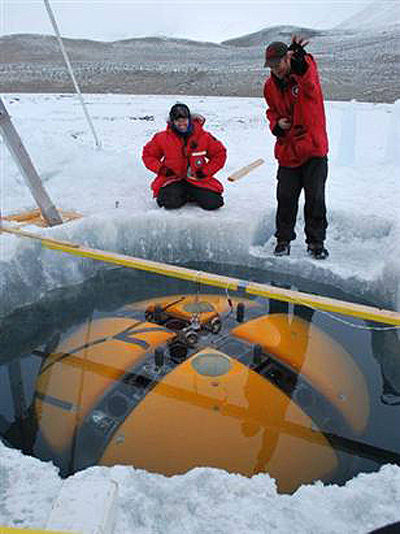ANTARCTIC DIVING ROBOT PRACTICES FOR EUROPA
April 9th, 2010
Categories: Applications, Devices, Software, User Groups, Visualization

About
Researchers want to reconfigure robot to explore beneath moon’s ice
by Henry Bortman
MSNBC.COM
April 9, 2010 - Europa is a unique moon of Jupiter that has fascinated scientists for hundreds of years. Its surface consists mostly of huge blocks of ice that have cracked and shifted about, suggesting that there may be an ocean beneath it, providing a home for living things. The intriguing characteristics of Europa have led to several ambitious ocean exploration proposals, but it won’t be easy. Europa’s ice is perhaps as much as 100 kilometers (62 miles) thick. But late last year, a group of NASA-funded scientists and engineers took an important step toward figuring out how it might be done.
The ENDURANCE project (Environmentally Non-Disturbing Under-Ice Robotic Antarctic Explorer) recently wrapped up its second field season at Lake Bonney, an ice-covered lake in Antarctica’s Dry Valleys. To date, ENDURANCE has successfully explored the entire west lobe of Lake Bonney, using sonar to produce a high-resolution bathymetric (depth) map and scientific instruments to collect data on temperature, salinity, pH, and several biological indicators, to produce the most extensive 3D biogeochemical map of any lake on Earth.
Peter Doran, professor of earth and environmental sciences at the University of Illinois at Chicago (UIC) and principal investigator for the ENDURANCE project, is working with UIC’s Electronic Visualization Laboratory’s (EVL) Andy Johnson, associate professor of computer science, and Alessandro Febretti, computer science graduate student, to produce 3D representations of Lake Bonney data that will enable scientists to interactively navigate through the data as though they were swimming through the lake. EVL is producing individual 3D plots of all the different parameters that highlight the structure of chemical, temperature and biological gradients within the lake. Combining multiple datasets into composite plots will enable the science team to visualize relationships between parameters.
ENDURANCE is funded by NASA, through its ASTEP (Astrobiology Science and Technology for Exploring Planets) program.